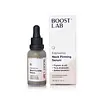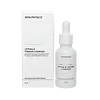What's inside
What's inside
 Key Ingredients
Key Ingredients

 Benefits
Benefits

 Ingredients Side-by-side
Ingredients Side-by-side

Loess Extract
Skin ConditioningCollagen Extract
Skin ConditioningPropanediol
SolventButylene Glycol
HumectantPentylene Glycol
Skin ConditioningGlycerin
HumectantLeontopodium Alpinum Callus Culture Extract
AntioxidantEragrostis Tef Seed Extract
EmollientRice Amino Acids
Skin ConditioningHydrolyzed Adansonia Digitata Seed Extract
Proline
Skin ConditioningHydrolyzed Vegetable Protein
Skin ConditioningXanthan Gum
EmulsifyingEthylhexylglycerin
Skin ConditioningPotassium Sorbate
PreservativeHydrolyzed Soy Protein
HumectantPhenoxyethanol
PreservativeSodium Benzoate
MaskingSodium Hydroxide
BufferingLoess Extract, Collagen Extract, Propanediol, Butylene Glycol, Pentylene Glycol, Glycerin, Leontopodium Alpinum Callus Culture Extract, Eragrostis Tef Seed Extract, Rice Amino Acids, Hydrolyzed Adansonia Digitata Seed Extract, Proline, Hydrolyzed Vegetable Protein, Xanthan Gum, Ethylhexylglycerin, Potassium Sorbate, Hydrolyzed Soy Protein, Phenoxyethanol, Sodium Benzoate, Sodium Hydroxide
Water
Skin ConditioningGlycerin
HumectantSodium Hyaluronate
HumectantSucrose Palmitate
EmollientOlea Europaea Leaf Extract
PerfumingTocopheryl Acetate
AntioxidantGlyceryl Linoleate
EmollientEthylhexylglycerin
Skin ConditioningBacillus Ferment
Skin ConditioningCyamopsis Tetragonoloba Gum
Emulsion StabilisingXanthan Gum
EmulsifyingTocopherol
AntioxidantCitric Acid
BufferingPotassium Sorbate
PreservativePhenoxyethanol
PreservativeDextran
Trifluoroacetyl Tripeptide-2
Skin ConditioningWater, Glycerin, Sodium Hyaluronate, Sucrose Palmitate, Olea Europaea Leaf Extract, Tocopheryl Acetate, Glyceryl Linoleate, Ethylhexylglycerin, Bacillus Ferment, Cyamopsis Tetragonoloba Gum, Xanthan Gum, Tocopherol, Citric Acid, Potassium Sorbate, Phenoxyethanol, Dextran, Trifluoroacetyl Tripeptide-2
Ingredients Explained
These ingredients are found in both products.
Ingredients higher up in an ingredient list are typically present in a larger amount.
Ethylhexylglycerin (we can't pronounce this either) is commonly used as a preservative and skin softener. It is derived from glyceryl.
You might see Ethylhexylglycerin often paired with other preservatives such as phenoxyethanol. Ethylhexylglycerin has been found to increase the effectiveness of these other preservatives.
Glycerin is already naturally found in your skin. It helps moisturize and protect your skin.
A study from 2016 found glycerin to be more effective as a humectant than AHAs and hyaluronic acid.
As a humectant, it helps the skin stay hydrated by pulling moisture to your skin. The low molecular weight of glycerin allows it to pull moisture into the deeper layers of your skin.
Hydrated skin improves your skin barrier; Your skin barrier helps protect against irritants and bacteria.
Glycerin has also been found to have antimicrobial and antiviral properties. Due to these properties, glycerin is often used in wound and burn treatments.
In cosmetics, glycerin is usually derived from plants such as soybean or palm. However, it can also be sourced from animals, such as tallow or animal fat.
This ingredient is organic, colorless, odorless, and non-toxic.
Glycerin is the name for this ingredient in American English. British English uses Glycerol/Glycerine.
Learn more about GlycerinPhenoxyethanol is a preservative that has germicide, antimicrobial, and aromatic properties. Studies show that phenoxyethanol can prevent microbial growth. By itself, it has a scent that is similar to that of a rose.
It's often used in formulations along with Caprylyl Glycol to preserve the shelf life of products.
Potassium Sorbate is a preservative used to prevent yeast and mold in products. It is commonly found in both cosmetic and food products.
This ingredient comes from potassium salt derived from sorbic acid. Sorbic acid is a natural antibiotic and effective against fungus.
Both potassium sorbate and sorbic acid can be found in baked goods, cheeses, dried meats, dried fruit, ice cream, pickles, wine, yogurt, and more.
You'll often find this ingredient used with other preservatives.
Learn more about Potassium SorbateXanthan gum is used as a stabilizer and thickener within cosmetic products. It helps give products a sticky, thick feeling - preventing them from being too runny.
On the technical side of things, xanthan gum is a polysaccharide - a combination consisting of multiple sugar molecules bonded together.
Xanthan gum is a pretty common and great ingredient. It is a natural, non-toxic, non-irritating ingredient that is also commonly used in food products.
Learn more about Xanthan Gum